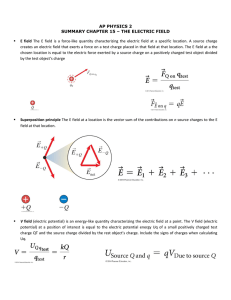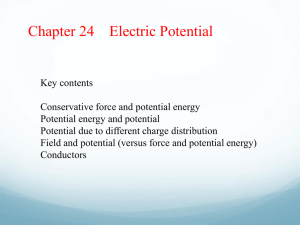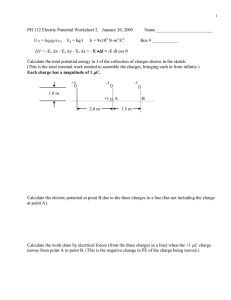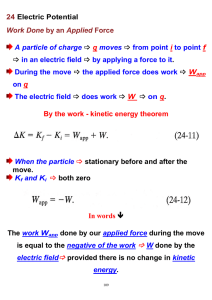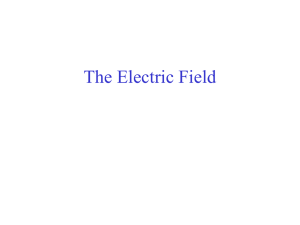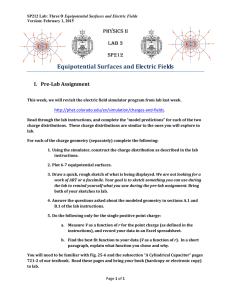Chapter 24 Electric Potential
advertisement
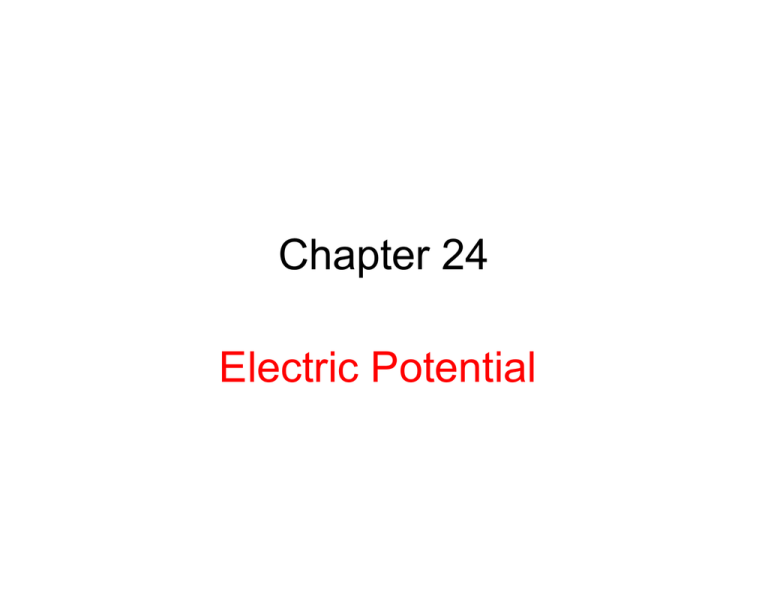
Chapter 24 Electric Potential 24.1 What is Physics?: Experimentally, physicists and engineers discovered that the electric force is conservative and thus has an associated electric potential energy. The motivation for associating a potential energy with a force is that we can then apply the principle of the conservation of mechanical energy to closed systems involving the force. Physics I Notes: W = F . D, ∆K = Kf - Ki ∆U = Uf - Ui = -W U A + KA = UB + KB 24.2: Electric Potential Energy When an electrostatic force acts between two or more charged particles within a system of particles, we can assign an electric potential energy U to the system. If the system changes its configuration from an initial state i to a different final state f, the electrostatic force does work W on the particles. If the resulting change is ΔU, then As with other conservative forces, the work done by the electrostatic force is path independent. Usually the reference configuration of a system of charged particles is taken to be that in which the particles are all infinitely separated from one another. The corresponding reference potential energy is usually set be zero. Therefore, Electric Potential Energy and the Electric Potential The electric force is conservative; therefore, there must be a potential energy associated with it. It takes work to move an electric charge perpendicular to an electric field: As usual, the change in potential energy is the negative of the work: Energy Conservation Since the force on a negative charge is opposite to the field direction, Positive charges accelerate in the direction of decreasing electric potential; Negative charges accelerate in the direction of increasing electric potential. In both cases, the charge moves to a region of lower potential energy. Example, Work and potential energy in an electric field: 24.3 Electric Potential: The potential energy per unit charge at a point in an electric field is called the electric potential V (or simply the potential) at that point. This is a scalar quantity. Thus, The electric potential difference V between any two points i and f in an electric field is equal to the difference in potential energy per unit charge between the two points. Thus, The potential difference between two points is thus the negative of the work done by the electrostatic force to move a unit charge from one point to the other. If we set Ui =0 at infinity as our reference potential energy, then the electric potential V must also be zero there. Therefore, the electric potential at any point in an electric field can be defined to be Here W∞ is the work done by the electric field on a charged particle as that particle moves in from infinity to point f. The SI unit for potential is the joule per coulomb. This combination is called the volt (abbreviated V). 24.3 Electric Potential: Units: This unit of volt allows us to adopt a more conventional unit for the electric field, E, which is expressed in newtons per coulomb. We can now define an energy unit that is a convenient one for energy measurements in the atomic/subatomic domain: One electron-volt (eV) is the energy equal to the work required to move a single elementary charge e, such as that of the electron or the proton, through a potential difference of exactly one volt. The magnitude of this work is qΔV, and 24.3 Electric Potential: Work done by an Applied Force: If a particle of charge q is moved from point i to point f in an electric field by applying a force to it, the applied force does work Wapp on the charge while the electric field does work W on it. The change K in the kinetic energy of the particle is If the particle is stationary before and after the move, Then Kf and Ki are both zero. Relating the work done by our applied force to the change in the potential energy of the particle during the move, one has We can also relate Wapp to the electric potential difference ΔV between the initial and final locations of the particle: Equipotential Surfaces and the Electric Field Electric potential and the electric field have the same relationship – there are lines (or, in three dimensions, surfaces) of constant potential. The electric field is perpendicular to these equipotential lines, and strongest where the lines are closest together. 24.4 Equipotential Surfaces: Adjacent points that have the same electric potential form an equipotential surface, which can be either an imaginary surface or a real, physical surface. No net work W is done on a charged particle by an electric field when the particle moves between two points i and f on the same equipotential surface. Fig. 24-2 Portions of four equipotential surfaces at electric potentials V1=100 V, V2=80 V,V3 =60 V, and V4 =40 V. Four paths along which a test charge may move are shown. Two electric field lines are also indicated. 24.7 Potential Due to a Group of Point Charges: The net potential at a point due to a group of point charges can be found with the help of the superposition principle. First the individual potential resulting from each charge is considered at the given point. Then we sum the potentials. For n charges, the net potential is Example, Net Potential of Several Charged Particles: Example, Potential is not a Vector: Example, Potential Energy of a System of Three Charged Particles: Equipotential Surfaces and the Electric Field There are electric fields inside the human body; the body is not a perfect conductor, so there are also potential differences. An electrocardiograph plots the heart’s electrical activity: Equipotential Surfaces and the Electric Field An electroencephalograph measures the electrical activity of the brain: 24.12 Spark Discharge from a Charge Conductor: On nonspherical conductors, a surface charge does not distribute itself uniformly over the surface of the conductor. At sharp points or edges, the surface charge density—and thus the external electric field, —may reach very high values. The air around such sharp points or edges may become ionized, producing the corona discharge that golfers and mountaineers see on the tips of bushes, golf clubs, and rock hammers when thunderstorms threaten. Such corona discharges are often the precursors of lightning strikes. In such circumstances, it is wise to enclose yourself in a cavity inside a conducting shell, where the electric field is guaranteed to be zero. A car (unless it is a convertible or made with a plastic body) is almost ideal 24.12 Isolated Conductor in an Isolated Electric Field: If an isolated conductor is placed in an external electric field, all points of the conductor still come to a single potential regardless of whether the conductor has an excess charge. The free conduction electrons distribute themselves on the surface in such a way that the electric field they produce at interior points cancels the external electric field that would otherwise be there. Furthermore, the electron distribution causes the net electric field at all points on the surface to be perpendicular to the surface. If the conductor in Fig. 24-20 could be somehow removed, leaving the surface charges frozen in place, the internal and external electric field would remain absolutely unchanged.

